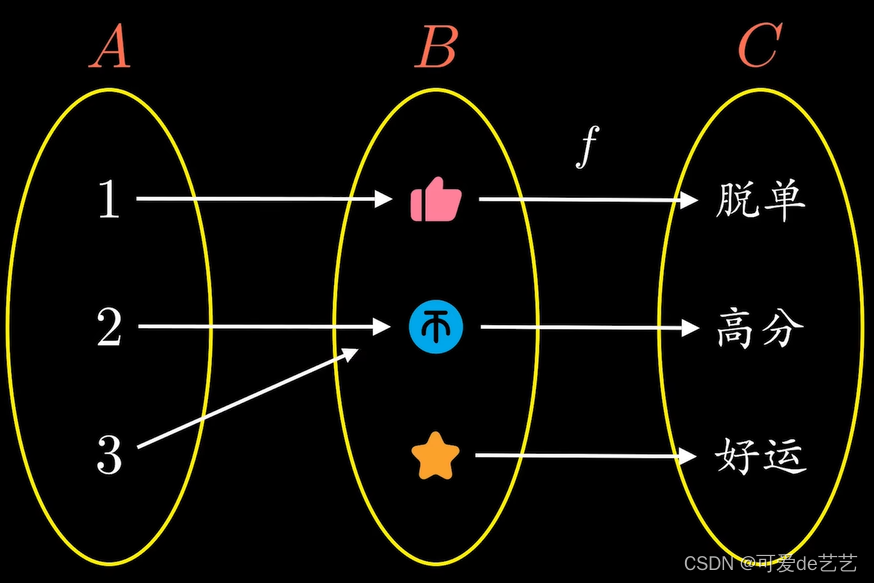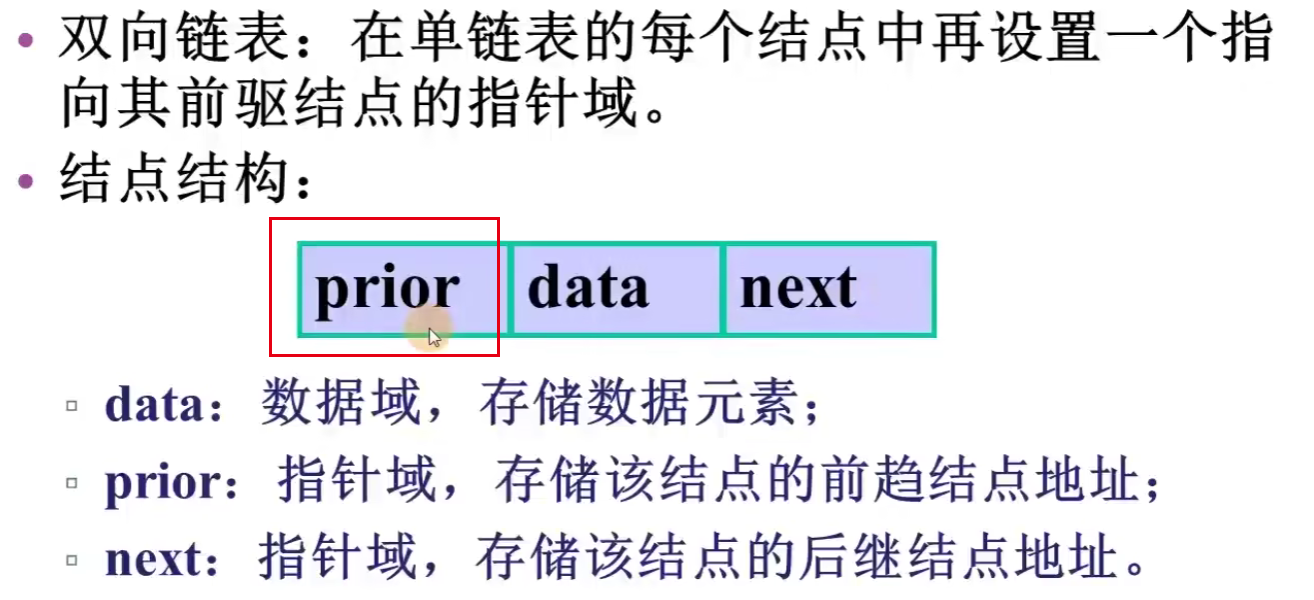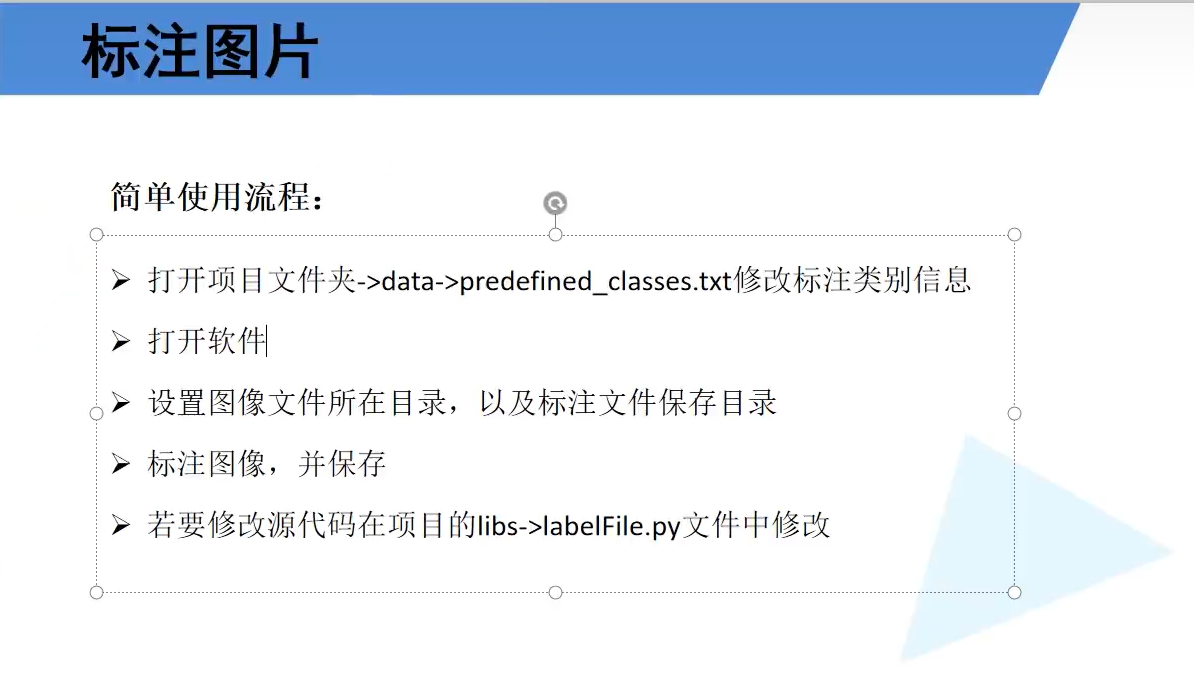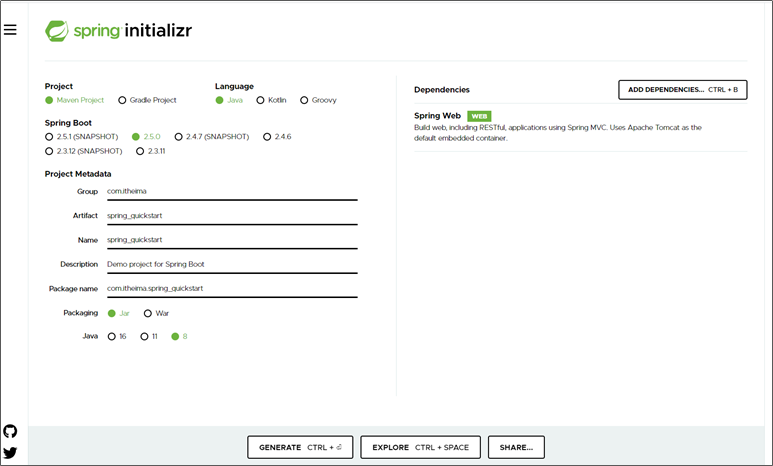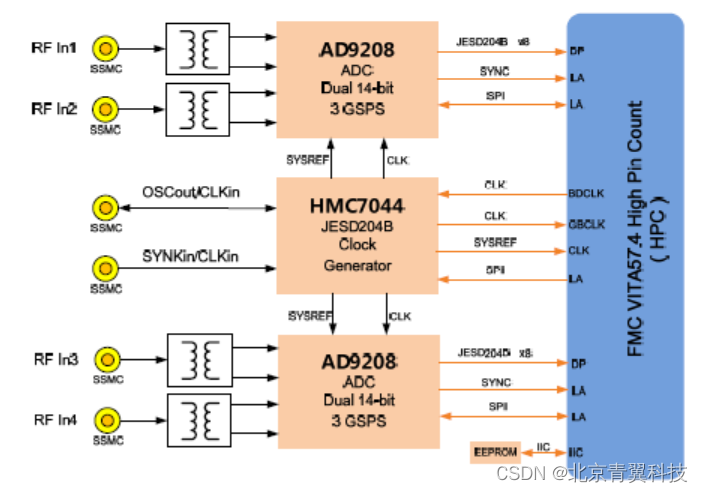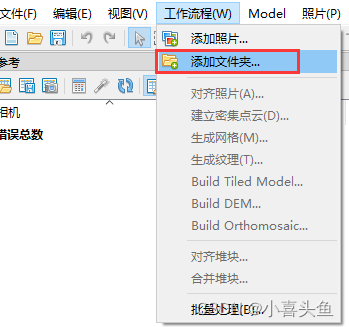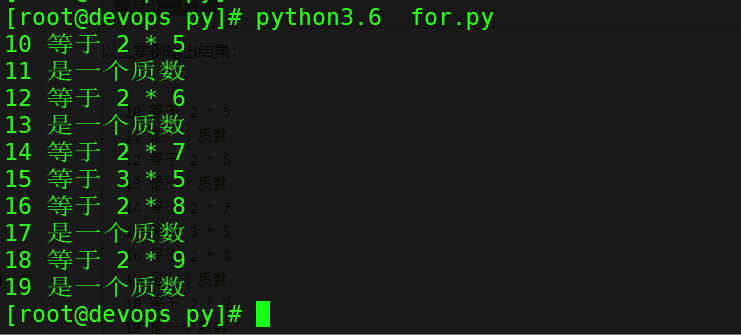NIO
在学习Netty之前,我们需要先了解一下NIO,以便更好的学习Netty
NIO是non-blocking io,也就是非阻塞IO
1.三大组件
1.1 channel & Buffer
channel 有一点类似于 stream,它就是读写数据的双向通道,可以从 channel 将数据读入 buffer,也可以将 buffer 的数据写入 channel,而之前的 stream 要么是输入,要么是输出,channel 比 stream 更为底层
常见的 Channel 有
- FileChannel
- DatagramChannel
- SocketChannel
- ServerSocketChannel
buffer 则用来缓冲读写数据,常见的 buffer 有
- ByteBuffer
- MappedByteBuffer
- DirectByteBuffer
- HeapByteBuffer
- ShortBuffer
- IntBuffer
- LongBuffer
- FloatBuffer
- DoubleBuffer
- CharBuffer
1.2 Selector
需要搭配实际案例来理解它的用途
假设我们现在需要设计一个聊天软件,那我们如何做到一个服务端与多个客户端通信呢?
多线程版设计
多线程版缺点
- 内存占用高,一个客户端一条线程
- 线程上下文切换成本高
- 只适合连接数少的场景
线程池版设计
线程池版缺点
- 阻塞模式下,线程仅能处理一个socket连接
- 仅适合短链接场景
selector版设计
selector 的作用就是配合一个线程来管理多个 channel,获取这些 channel 上发生的事件,这些 channel 工作在非阻塞模式下,不会让线程吊死在一个 channel 上。适合连接数特别多,但流量低的场景(low traffic)
调用 selector 的 select() 会阻塞直到 channel 发生了读写就绪事件,这些事件发生,select 方法就会返回这些事件交给 thread 来处理
举个实际生活中的案例,餐厅中的服务员就是一个thread,而每桌的顾客就是一个channel,一个服务员负责多组顾客,而服务员需要一个监视器,监视器就是selector,例如海底捞的服务员他的selector就是他的眼睛,当看到顾客桌子上没饮品时过去帮忙加上。
2. ByteBuffer
通过以下一个案例来了解ByteBuffer
@Slf4j
@SpringBootTest
public class TestByteBuffer {
@Test
public void byteBuffer(){
/**
* 获取FileChannel(两种方式)
* 1. 输入输出流
* 2. RandomAccessFile
*/
try(FileChannel channel = new FileInputStream("test.txt").getChannel()) { //channel实现了Closeable接口,可以结束时自动释放资源
//创建一个缓冲区
ByteBuffer buffer = ByteBuffer.allocate(10);
while (true) {
//从channel中读取数据,写入buffer
int len = channel.read(buffer);
log.debug("当前读取字节数:{}" , len);
if (len == -1) { //len为-1时代表数据已经读完
break;
}
//打印buffer中的内容
buffer.flip(); //将buffer切换为读模式
while (buffer.hasRemaining()) { //只要buffer中还有数据就一直读
byte b = buffer.get();
log.debug("实际字节:{}", (char) b);
}
buffer.clear(); //将buffer切换为写模式
}
}catch (IOException e) {
}
}
}
输出如下
13:37:44 [DEBUG] [main] c.y.n.TestByteBuffer - 当前读取字节数:10
13:37:44 [DEBUG] [main] c.y.n.TestByteBuffer - 实际字节:1
13:37:44 [DEBUG] [main] c.y.n.TestByteBuffer - 实际字节:2
13:37:44 [DEBUG] [main] c.y.n.TestByteBuffer - 实际字节:3
13:37:44 [DEBUG] [main] c.y.n.TestByteBuffer - 实际字节:4
13:37:44 [DEBUG] [main] c.y.n.TestByteBuffer - 实际字节:5
13:37:44 [DEBUG] [main] c.y.n.TestByteBuffer - 实际字节:6
13:37:44 [DEBUG] [main] c.y.n.TestByteBuffer - 实际字节:7
13:37:44 [DEBUG] [main] c.y.n.TestByteBuffer - 实际字节:8
13:37:44 [DEBUG] [main] c.y.n.TestByteBuffer - 实际字节:9
13:37:44 [DEBUG] [main] c.y.n.TestByteBuffer - 实际字节:0
13:37:44 [DEBUG] [main] c.y.n.TestByteBuffer - 当前读取字节数:4
13:37:44 [DEBUG] [main] c.y.n.TestByteBuffer - 实际字节:a
13:37:44 [DEBUG] [main] c.y.n.TestByteBuffer - 实际字节:b
13:37:44 [DEBUG] [main] c.y.n.TestByteBuffer - 实际字节:c
13:37:44 [DEBUG] [main] c.y.n.TestByteBuffer - 实际字节:d
13:37:44 [DEBUG] [main] c.y.n.TestByteBuffer - 当前读取字节数:-1
2.1 正确使用步骤
- 向ByteBuffer中写入数据
- 调用
flip()方法将buffer切换为读模式 - 从ByteBuffer中读数据
- 调用
clear()方法将buffer切换为写模式 - 重复1-4步骤
2.2 内部结构
通过观察源码,可以发现ByteBuffer有几个比较重要的属性
- position:类似于循环中的指针,position标记的是下一个待读/写的位置
- limit:写入/读取限制
- capacity:容量
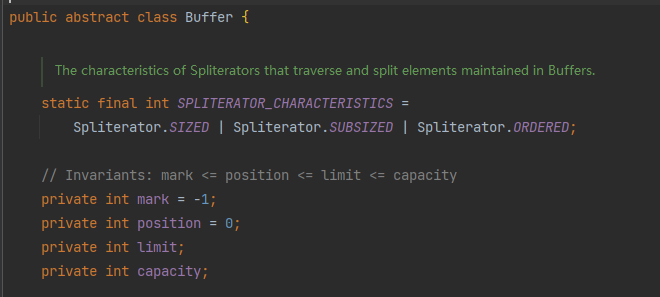
执行以下代码创建一个新的ByteBuffer
通过allocate()创建的ByteBuffer默认是在写模式下
ByteBuffer buffer = ByteBuffer.allocate(10);

下图表示写入了4个数据后的状态
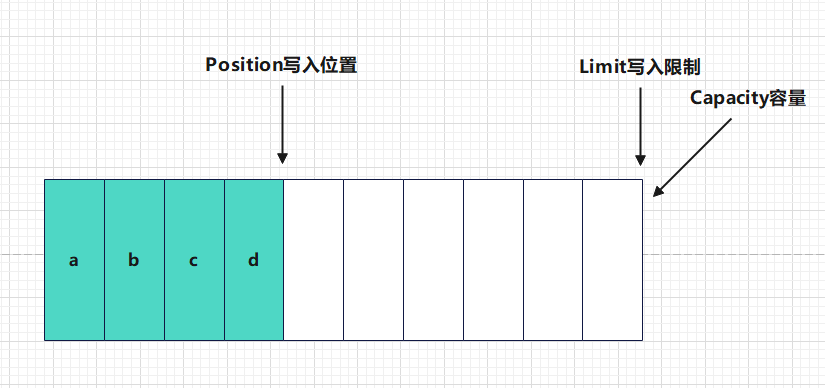
通过调用flip()方法将ByteBuffer切换为读模式,以下是flip()源码以及切换后的状态
public final Buffer flip() {
limit = position;
position = 0;
mark = -1;
return this;
}
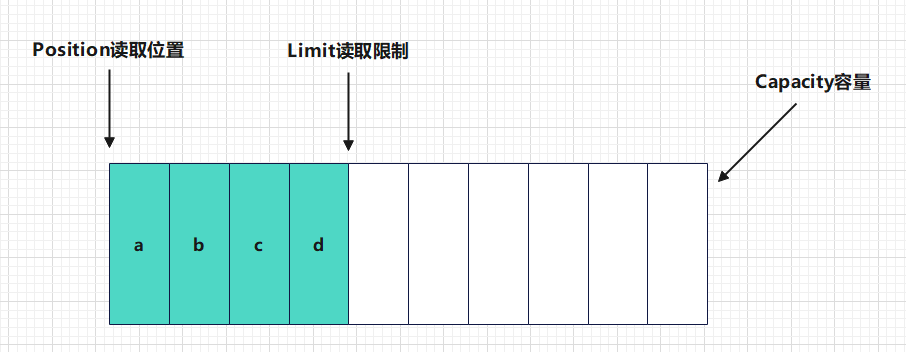
调用get()方法读取4个字节后的状态如下
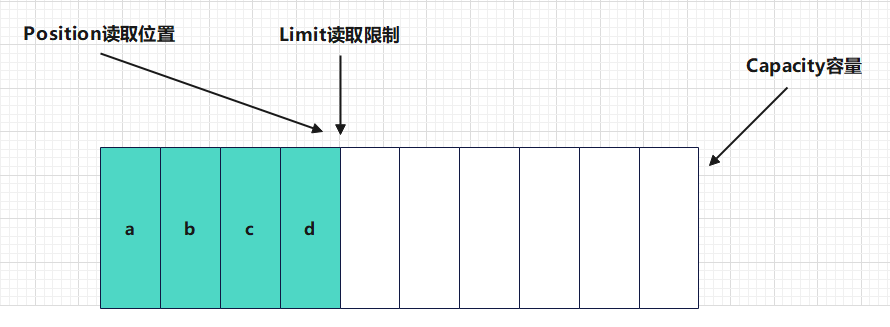
调用clear()方法切换为写模式
public final Buffer clear() {
position = 0;
limit = capacity;
mark = -1;
return this;
}
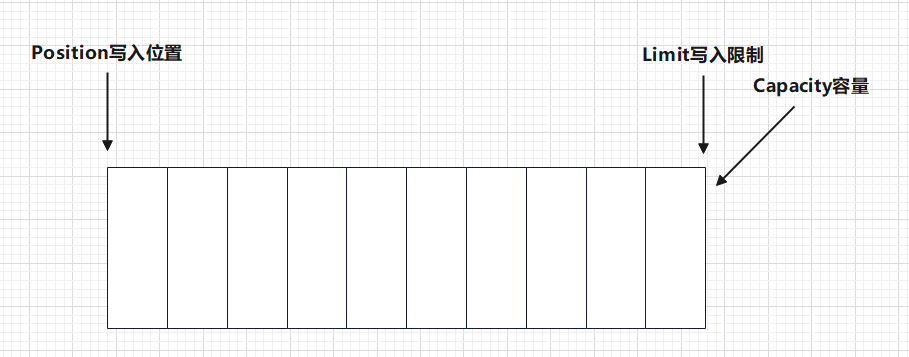
另外还有一个compact() 方法,是把未读完的部分向前压缩,然后切换至写模式

调试工具类
public class ByteBufferUtil {
private static final char[] BYTE2CHAR = new char[256];
private static final char[] HEXDUMP_TABLE = new char[256 * 4];
private static final String[] HEXPADDING = new String[16];
private static final String[] HEXDUMP_ROWPREFIXES = new String[65536 >>> 4];
private static final String[] BYTE2HEX = new String[256];
private static final String[] BYTEPADDING = new String[16];
static {
final char[] DIGITS = "0123456789abcdef".toCharArray();
for (int i = 0; i < 256; i++) {
HEXDUMP_TABLE[i << 1] = DIGITS[i >>> 4 & 0x0F];
HEXDUMP_TABLE[(i << 1) + 1] = DIGITS[i & 0x0F];
}
int i;
// Generate the lookup table for hex dump paddings
for (i = 0; i < HEXPADDING.length; i++) {
int padding = HEXPADDING.length - i;
StringBuilder buf = new StringBuilder(padding * 3);
for (int j = 0; j < padding; j++) {
buf.append(" ");
}
HEXPADDING[i] = buf.toString();
}
// Generate the lookup table for the start-offset header in each row (up to 64KiB).
for (i = 0; i < HEXDUMP_ROWPREFIXES.length; i++) {
StringBuilder buf = new StringBuilder(12);
buf.append(NEWLINE);
buf.append(Long.toHexString(i << 4 & 0xFFFFFFFFL | 0x100000000L));
buf.setCharAt(buf.length() - 9, '|');
buf.append('|');
HEXDUMP_ROWPREFIXES[i] = buf.toString();
}
// Generate the lookup table for byte-to-hex-dump conversion
for (i = 0; i < BYTE2HEX.length; i++) {
BYTE2HEX[i] = ' ' + StringUtil.byteToHexStringPadded(i);
}
// Generate the lookup table for byte dump paddings
for (i = 0; i < BYTEPADDING.length; i++) {
int padding = BYTEPADDING.length - i;
StringBuilder buf = new StringBuilder(padding);
for (int j = 0; j < padding; j++) {
buf.append(' ');
}
BYTEPADDING[i] = buf.toString();
}
// Generate the lookup table for byte-to-char conversion
for (i = 0; i < BYTE2CHAR.length; i++) {
if (i <= 0x1f || i >= 0x7f) {
BYTE2CHAR[i] = '.';
} else {
BYTE2CHAR[i] = (char) i;
}
}
}
/**
* 打印所有内容
* @param buffer
*/
public static void debugAll(ByteBuffer buffer) {
int oldlimit = buffer.limit();
buffer.limit(buffer.capacity());
StringBuilder origin = new StringBuilder(256);
appendPrettyHexDump(origin, buffer, 0, buffer.capacity());
System.out.println("+--------+-------------------- all ------------------------+----------------+");
System.out.printf("position: [%d], limit: [%d]\n", buffer.position(), oldlimit);
System.out.println(origin);
buffer.limit(oldlimit);
}
/**
* 打印可读取内容
* @param buffer
*/
public static void debugRead(ByteBuffer buffer) {
StringBuilder builder = new StringBuilder(256);
appendPrettyHexDump(builder, buffer, buffer.position(), buffer.limit() - buffer.position());
System.out.println("+--------+-------------------- read -----------------------+----------------+");
System.out.printf("position: [%d], limit: [%d]\n", buffer.position(), buffer.limit());
System.out.println(builder);
}
private static void appendPrettyHexDump(StringBuilder dump, ByteBuffer buf, int offset, int length) {
if (isOutOfBounds(offset, length, buf.capacity())) {
throw new IndexOutOfBoundsException(
"expected: " + "0 <= offset(" + offset + ") <= offset + length(" + length
+ ") <= " + "buf.capacity(" + buf.capacity() + ')');
}
if (length == 0) {
return;
}
dump.append(
" +-------------------------------------------------+" +
NEWLINE + " | 0 1 2 3 4 5 6 7 8 9 a b c d e f |" +
NEWLINE + "+--------+-------------------------------------------------+----------------+");
final int startIndex = offset;
final int fullRows = length >>> 4;
final int remainder = length & 0xF;
// Dump the rows which have 16 bytes.
for (int row = 0; row < fullRows; row++) {
int rowStartIndex = (row << 4) + startIndex;
// Per-row prefix.
appendHexDumpRowPrefix(dump, row, rowStartIndex);
// Hex dump
int rowEndIndex = rowStartIndex + 16;
for (int j = rowStartIndex; j < rowEndIndex; j++) {
dump.append(BYTE2HEX[getUnsignedByte(buf, j)]);
}
dump.append(" |");
// ASCII dump
for (int j = rowStartIndex; j < rowEndIndex; j++) {
dump.append(BYTE2CHAR[getUnsignedByte(buf, j)]);
}
dump.append('|');
}
// Dump the last row which has less than 16 bytes.
if (remainder != 0) {
int rowStartIndex = (fullRows << 4) + startIndex;
appendHexDumpRowPrefix(dump, fullRows, rowStartIndex);
// Hex dump
int rowEndIndex = rowStartIndex + remainder;
for (int j = rowStartIndex; j < rowEndIndex; j++) {
dump.append(BYTE2HEX[getUnsignedByte(buf, j)]);
}
dump.append(HEXPADDING[remainder]);
dump.append(" |");
// Ascii dump
for (int j = rowStartIndex; j < rowEndIndex; j++) {
dump.append(BYTE2CHAR[getUnsignedByte(buf, j)]);
}
dump.append(BYTEPADDING[remainder]);
dump.append('|');
}
dump.append(NEWLINE +
"+--------+-------------------------------------------------+----------------+");
}
private static void appendHexDumpRowPrefix(StringBuilder dump, int row, int rowStartIndex) {
if (row < HEXDUMP_ROWPREFIXES.length) {
dump.append(HEXDUMP_ROWPREFIXES[row]);
} else {
dump.append(NEWLINE);
dump.append(Long.toHexString(rowStartIndex & 0xFFFFFFFFL | 0x100000000L));
dump.setCharAt(dump.length() - 9, '|');
dump.append('|');
}
}
public static short getUnsignedByte(ByteBuffer buffer, int index) {
return (short) (buffer.get(index) & 0xFF);
}
}
2.3 常见方法
分配空间
可以使用 allocate() 方法为 ByteBuffer 分配空间,其它 buffer 类也有该方法
Bytebuffer buf = ByteBuffer.allocate(16);
向 buffer 写入数据
有两种办法
-
调用 channel 的
read()方法int readBytes = channel.read(buf); -
调用 buffer 自己的
put()方法buf.put((byte)61);
从 buffer 读取数据
同样有两种办法
-
调用 channel 的
write()方法int writeBytes = channel.write(buf); -
调用 buffer 自己的
get()方法byte b = buf.get();
get 方法会让 position 读指针向后走,如果想重复读取数据
- 可以调用
rewind()方法将 position 重新置为 0 - 或者调用
get(int i)方法获取索引 i 的内容,它不会移动读指针
mark 和 reset
mark 是在读取时,做一个标记,即使 position 改变,只要调用 reset 就能回到 mark 的位置
注意
rewind 和 flip 都会清除 mark 位置
创建ByteBuffer的方式
通过ByteBuffer.allocate(16)创建,此方法创建后,ByteBuffer默认是写模式。可以从postion=5看出
@Test
public void byteBuffer1() {
ByteBuffer buffer = ByteBuffer.allocate(16);
buffer.put("hello".getBytes());
ByteBufferUtil.debugAll(buffer);
}

通过StandardCharsets来创建,此方法创建出的ByteBuffer模式是读模式
@Test
public void byteBuffer2() {
ByteBuffer buffer = StandardCharsets.UTF_8.encode("hello");
ByteBufferUtil.debugAll(buffer);
}

通过ByteBuffer.wrap()方法创建,此方法创建出的ByteBuffer模式也是读模式
@Test
public void byteBuffer3() {
ByteBuffer buffer = ByteBuffer.wrap("hello".getBytes());
ByteBufferUtil.debugAll(buffer);
}
2.4 分散读集中写
了解即可
Scattering Reads
分散读,指的是将一条信息,分批读到不同的ByteBuffer中
例如:demo.txt文件中有这么一行信息hello123world,现在我们需要将hello,123,world分别读出来
@Test
public void scatteringRead(){
//使用RandomAccessFile创建channel
try (FileChannel channel = new RandomAccessFile("demo.txt", "r").getChannel()) { // r表示只读
ByteBuffer b1 = ByteBuffer.allocate(5);
ByteBuffer b2 = ByteBuffer.allocate(3);
ByteBuffer b3 = ByteBuffer.allocate(5);
channel.read(new ByteBuffer[]{b1,b2,b3});
ByteBufferUtil.debugAll(b1);
ByteBufferUtil.debugAll(b2);
ByteBufferUtil.debugAll(b3);
} catch (IOException e) {
}
}
结果如下

Gathering Writes
集中写,指的是将多个ByteBuffer里的数据集中写入一个文件中
例如:现在有3个ByteBuffer,里面的数据为yellow,star,459现在将他们组合起来写入demo2.txt文件
这里需要注意的是通过StandardCharsets.UTF_8.encode("yellow")创建的ByteBuffer已经是读模式,不要重复使用flip(),否则会导致读不到数据
@Test
public void gatheringWrites(){
try (FileChannel channel = new RandomAccessFile("demo2.txt", "rw").getChannel()) { // rw代表读写
ByteBuffer b1 = StandardCharsets.UTF_8.encode("yellow");
ByteBuffer b2 = StandardCharsets.UTF_8.encode("star");
ByteBuffer b3 = StandardCharsets.UTF_8.encode("459");
channel.write(new ByteBuffer[]{b1,b2,b3});
} catch (IOException e) {
}
}
2.5 黏包、半包
网络上有多条数据发送给服务端,数据之间使用 \n 进行分隔
但由于某种原因这些数据在接收时,被进行了重新组合,例如原始数据有3条为
- Hello,world\n
- I’m zhangsan\n
- How are you?\n
变成了下面的两个 byteBuffer (黏包,半包)
- Hello,world\nI’m zhangsan\nHo
- w are you?\n
现在要求你编写程序,将错乱的数据恢复成原始的按 \n 分隔的数据
public class TestByteBuffer2 {
public static void main(String[] args) {
ByteBuffer source = ByteBuffer.allocate(32);
source.put("Hello,world\nI'm zhangsan\nHo".getBytes());
split(source);
source.put("w are you?\nhaha!\n".getBytes());
split(source);
}
private static void split(ByteBuffer buffer) {
//将buffer转为读模式
buffer.flip();
int limit = buffer.limit();
for (int i = 0; i < limit; i++) {
if (buffer.get(i) == '\n') {
int length = i + 1 - buffer.position();
//用一个ByteBuffer存起来
ByteBuffer temp = ByteBuffer.allocate(length);
buffer.limit(i + 1);
//从buffer读,写到temp
temp.put(buffer);
ByteBufferUtil.debugAll(temp);
buffer.limit(limit);
}
}
buffer.compact();
}
}
测试结果如下:
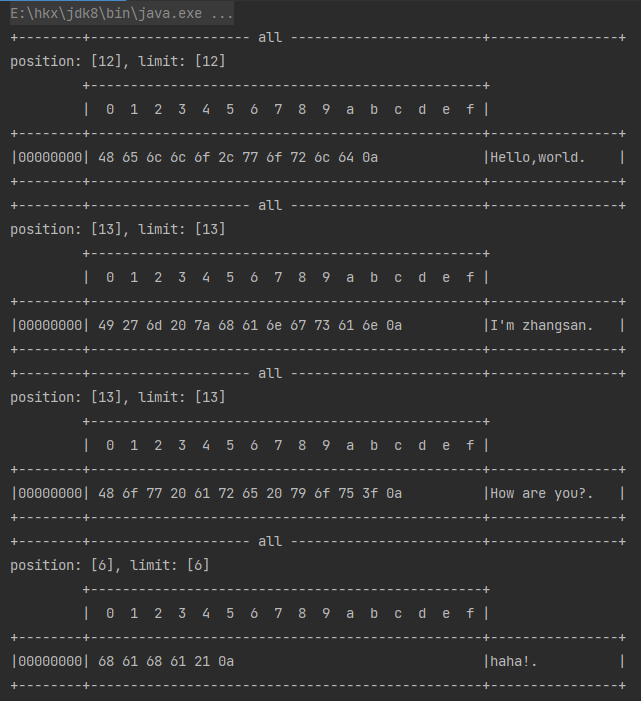
3. 文件编程
3.1FileChannel
工作模式
FileChannel只能工作在阻塞模式下
获取
不能直接打开 FileChannel,必须通过 FileInputStream、FileOutputStream 或者 RandomAccessFile 来获取 FileChannel,它们都有 getChannel 方法
- 通过 FileInputStream 获取的 channel 只能读
- 通过 FileOutputStream 获取的 channel 只能写
- 通过 RandomAccessFile 是否能读写根据构造 RandomAccessFile 时的读写模式决定
读取
会从 channel 读取数据填充 ByteBuffer,返回值表示读到了多少字节,-1 表示到达了文件的末尾
int readBytes = channel.read(buffer);
写入
写入的正确姿势如下, SocketChannel
ByteBuffer buffer = ...;
buffer.put(...); // 存入数据
buffer.flip(); // 切换读模式
while(buffer.hasRemaining()) {
channel.write(buffer);
}
在 while 中调用 channel.write 是因为 write 方法并不能保证一次将 buffer 中的内容全部写入 channel
关闭
channel 必须关闭,不过调用了 FileInputStream、FileOutputStream 或者 RandomAccessFile 的 close 方法会间接地调用 channel 的 close 方法
位置
获取当前位置
long pos = channel.position();
设置当前位置
long newPos = ...;
channel.position(newPos);
设置当前位置时,如果设置为文件的末尾
- 这时读取会返回 -1
- 这时写入,会追加内容,但要注意如果 position 超过了文件末尾,再写入时在新内容和原末尾之间会有空洞(00)
大小
使用 size 方法获取文件的大小
强制写入
操作系统出于性能的考虑,会将数据缓存,不是立刻写入磁盘。可以调用 force(true) 方法将文件内容和元数据(文件的权限等信息)立刻写入磁盘
3.2 两个Channel传输数据
现在有这么个需求,将demo.txt中的数据复制到to.txt中
@SpringBootTest
public class TestChannel {
@Test
public void transferTo(){
try (
FileChannel from = new FileInputStream("demo.txt").getChannel();
FileChannel to = new FileOutputStream("to.txt").getChannel()
) {
from.transferTo(0,from.size(),to);
} catch (IOException e) {
}
}
}
以上代码确实可以达到复制的效果,但transferTo一次只能读到2g大小的内容,所以当文件大小超过2g时,需要循环读取
@SpringBootTest
public class TestChannel {
@Test
public void transferTo(){
try (
FileChannel from = new FileInputStream("demo.txt").getChannel();
FileChannel to = new FileOutputStream("to.txt").getChannel()
) {
long size = from.size();
//left表示还有多少文件未读取
for (long left = size;left > 0;) {
left -= from.transferTo(0, size, to);
}
} catch (IOException e) {
}
}
}
3.3 Path
jdk7 引入了 Path 和 Paths 类
- Path 用来表示文件路径
- Paths 是工具类,用来获取 Path 实例
Path source = Paths.get("1.txt"); // 相对路径 使用 user.dir 环境变量来定位 1.txt
Path source = Paths.get("d:\\1.txt"); // 绝对路径 代表了 d:\1.txt
Path source = Paths.get("d:/1.txt"); // 绝对路径 同样代表了 d:\1.txt
Path projects = Paths.get("d:\\data", "projects"); // 代表了 d:\data\projects
.代表了当前路径..代表了上一级路径
例如目录结构如下
d:
|- data
|- projects
|- a
|- b
代码
Path path = Paths.get("d:\\data\\projects\\a\\..\\b");
System.out.println(path);
System.out.println(path.normalize()); // 正常化路径
会输出
d:\data\projects\a\..\b
d:\data\projects\b
3.4 Files
主要学习一下API的用法
检查文件是否存在
@Test
public void test1(){
Path path = Paths.get("demo11.txt");
boolean exists = Files.exists(path);
System.out.println(exists);
}
创建一级目录
@Test
public void test2() throws IOException {
Path path = Paths.get("hello");
Files.createDirectory(path);
}
如果目录已存在会报FileAlreadyExistsException错误
一次创建多级目录,会报NoSuchFileException错误
创建多级目录
@Test
public void test3() throws IOException {
Path path = Paths.get("hello1/d1");
Files.createDirectories(path);
}
拷贝文件
@Test
public void test4() throws IOException {
Path source = Paths.get("hello/source.txt");
Path target = Paths.get("hello/target.txt");
Files.copy(source,target);
}
如果文件已存在,会报FileAlreadyExistsException错误
可以使用StandardCopyOption.REPLACE_EXISTING表示存在则替换
Files.copy(source,target, StandardCopyOption.REPLACE_EXISTING);
移动文件
@Test
public void test5() throws IOException {
Path source = Paths.get("hello/source.txt");
Path target = Paths.get("hello1/source.txt");
Files.move(source,target, StandardCopyOption.ATOMIC_MOVE);
}
StandardCopyOption.ATOMIC_MOVE保证文件移动的原子性
删除文件
@Test
public void test6() throws IOException {
Path path = Paths.get("hello1/source.txt");
Files.delete(path);
}
如果文件不存在,会报NoSuchFileException错误
遍历目录文件
@Test
public void test7() throws IOException {
Path path = Paths.get("E:\\hkx\\apache-maven-3.9.1");
AtomicInteger dirCount = new AtomicInteger();
AtomicInteger fileCount = new AtomicInteger();
Files.walkFileTree(path,new SimpleFileVisitor<Path>(){
@Override
public FileVisitResult preVisitDirectory(Path dir, BasicFileAttributes attrs) throws IOException {
System.out.println("====> " + dir);
dirCount.incrementAndGet();
return super.preVisitDirectory(dir, attrs);
}
@Override
public FileVisitResult visitFile(Path file, BasicFileAttributes attrs) throws IOException {
System.out.println(file);
fileCount.incrementAndGet();
return super.visitFile(file, attrs);
}
});
System.out.println("文件夹数量:" + dirCount);
System.out.println("文件数量:" + fileCount);
}
统计jar的数目
@Test
public void test8() throws IOException {
Path path = Paths.get("E:\\hkx\\apache-maven-3.9.1");
AtomicInteger jarCount = new AtomicInteger();
Files.walkFileTree(path,new SimpleFileVisitor<Path>(){
@Override
public FileVisitResult visitFile(Path file, BasicFileAttributes attrs) throws IOException {
if (file.toString().endsWith(".jar")) {
System.out.println(file);
jarCount.incrementAndGet();
}
return super.visitFile(file, attrs);
}
});
System.out.println("jar数量:" + jarCount);
}
删除多级目录
目录下如果有东西存在,则不能直接删除,会报DirectoryNotEmptyException错误
也就是说只有目录为空时才能删除目录,所以我们要遍历整个文件夹,先删除文件在删除目录
@Test
public void test9() throws IOException {
Path path = Paths.get("E:\\nacos");
Files.walkFileTree(path,new SimpleFileVisitor<Path>(){
@Override
public FileVisitResult visitFile(Path file, BasicFileAttributes attrs) throws IOException {
Files.delete(file);
return super.visitFile(file, attrs);
}
@Override
public FileVisitResult postVisitDirectory(Path dir, IOException exc) throws IOException {
Files.delete(dir);
return super.postVisitDirectory(dir, exc);
}
});
}
删除是危险操作,确保要递归删除的文件夹没有重要内容!
拷贝多级目录
@Test
public void test10() throws IOException {
String source = "E:\\nacos";
String target = "E:\\nacosaaa";
Files.walk(Paths.get(source)).forEach(path -> {
try {
String file = path.toString().replace(source,target);
//如果是目录则创建
if (Files.isDirectory(path)) {
Files.createDirectory(Paths.get(file));
}else if (Files.isRegularFile(path)){ //如果是普通文件
Files.copy(path,Paths.get(file));
}
}catch (IOException e) {
e.printStackTrace();
}
});
}
4. 网络编程
4.1 阻塞 vs 非阻塞
阻塞
- 阻塞模式下,相关方法都会导致线程暂停
- ServerSocketChannel.accept 会在没有连接建立时让线程暂停
- SocketChannel.read 会在没有数据可读时让线程暂停
- 阻塞的表现其实就是线程暂停了,暂停期间不会占用 cpu,但线程相当于闲置
- 单线程下,阻塞方法之间相互影响,几乎不能正常工作,需要多线程支持
- 但多线程下,有新的问题,体现在以下方面
- 32 位 jvm 一个线程 320k,64 位 jvm 一个线程 1024k,如果连接数过多,必然导致 OOM,并且线程太多,反而会因为频繁上下文切换导致性能降低
- 可以采用线程池技术来减少线程数和线程上下文切换,但治标不治本,如果有很多连接建立,但长时间 inactive,会阻塞线程池中所有线程,因此不适合长连接,只适合短连接
服务端代码
@Slf4j
public class Server {
public static void main(String[] args) throws IOException {
// 1.创建服务器
ServerSocketChannel ssc = ServerSocketChannel.open();
// 2.绑定监听端口
ssc.bind(new InetSocketAddress(8080));
// 3.建立连接集合
ArrayList<SocketChannel> channels = new ArrayList<>();
while (true) {
// 4.accept 建立与客户端连接, SocketChannel 用来与客户端之间通信
log.debug("connecting...");
SocketChannel socketChannel = ssc.accept(); // 阻塞方法,线程停止运行
log.debug("connected!");
channels.add(socketChannel);
for (SocketChannel channel : channels) {
// 5.开辟一个缓存区
ByteBuffer buffer = ByteBuffer.allocate(16);
log.debug("before read... {}", channel);
channel.read(buffer); // 阻塞方法,线程停止运行
// 6.切换为读模式
buffer.flip();
ByteBufferUtil.debugRead(buffer);
// 7.切换为写模式
buffer.clear();
log.debug("after read...{}", channel);
}
}
}
}
客户端代码
客户端代码就很简单
public class Client {
public static void main(String[] args) throws IOException {
SocketChannel sc = SocketChannel.open();
sc.connect(new InetSocketAddress("localhost",8080));
System.out.println();
}
}
非阻塞
- 非阻塞模式下,相关方法都会不会让线程暂停
- 在 ServerSocketChannel.accept 在没有连接建立时,会返回 null,继续运行
- SocketChannel.read 在没有数据可读时,会返回 0,但线程不必阻塞,可以去执行其它 SocketChannel 的 read 或是去执行 ServerSocketChannel.accept
- 写数据时,线程只是等待数据写入 Channel 即可,无需等 Channel 通过网络把数据发送出去
- 但非阻塞模式下,即使没有连接建立,和可读数据,线程仍然在不断运行,白白浪费了 cpu
- 数据复制过程中,线程实际还是阻塞的(AIO 改进的地方)
服务端代码
服务端代码小小的改动一下,客户端代码不变
主要修改configureBlocking(false)修改为非阻塞状态
@Slf4j
public class Server2 {
public static void main(String[] args) throws IOException {
// 1.创建服务器
ServerSocketChannel ssc = ServerSocketChannel.open();
// 2.绑定监听端口
ssc.bind(new InetSocketAddress(8080));
// 设置服务器为非阻塞状态
ssc.configureBlocking(false);
// 3.建立连接集合
ArrayList<SocketChannel> channels = new ArrayList<>();
while (true) {
// 4.accept 建立与客户端连接, SocketChannel 用来与客户端之间通信
SocketChannel socketChannel = ssc.accept(); //如果没有连接,返回null
if (socketChannel != null) {
// 设置通道为非阻塞状态
socketChannel.configureBlocking(false);
log.debug("connected!");
channels.add(socketChannel);
}
for (SocketChannel channel : channels) {
// 5.开辟一个缓存区
ByteBuffer buffer = ByteBuffer.allocate(16);
int read = channel.read(buffer);// 如果没有读到字节返回0
if (read > 0) {
// 6.切换为读模式
buffer.flip();
ByteBufferUtil.debugRead(buffer);
// 7.切换为写模式
buffer.clear();
log.debug("after read...{}", channel);
}
}
}
}
}
缺点
即使没有请求连接时,程序也在不断循环,造成了资源浪费!
4.2 Selector
好处
- 一个线程配合 selector 就可以监控多个 channel 的事件,事件发生线程才去处理。避免非阻塞模式下所做无用功
- 让这个线程能够被充分利用
- 节约了线程的数量
- 减少了线程上下文切换
创建
Selector selector = Selector.open();
绑定Channel事件
也称之为注册事件,绑定的事件 selector 才会关心
ssc.configureBlocking(false);
SelectionKey sscKey = ssc.register(selector, 0, null);
//绑定事件类型
sscKey.interestOps(SelectionKey.OP_ACCEPT);
- channel必须工作在非阻塞模式
- FileChannel没有非阻塞模式,因此不能配合selector使用
- 绑定的事件类型有:
- connect:客户端连接成功时触发
- accept:服务端成功接受连接时出发
- read:数据可读入时触发,有因为接受能力弱,数据暂时不能读入的情况
- write:数据可写出时触发,有因为发送能力弱,数据在那时不能写出的情况
监听 Channel 事件
可以通过下面三种方法来监听是否有事件发生,方法的返回值代表有多少 channel 发生了事件
方法1,阻塞直到绑定事件发生
int count = selector.select();
方法2,阻塞直到绑定事件发生,或是超时(时间单位为 ms)
int count = selector.select(long timeout);
方法3,不会阻塞,也就是不管有没有事件,立刻返回,自己根据返回值检查是否有事件
int count = selector.selectNow();
4.3 处理accept事件
客户端代码依旧不变,服务端代码如下
@Slf4j
public class Server3 {
public static void main(String[] args) throws IOException {
//1.创建selector
Selector selector = Selector.open();
//2.创建用于监听服务连接的channel
ServerSocketChannel ssc = ServerSocketChannel.open();
ssc.bind(new InetSocketAddress(8080));
ssc.configureBlocking(false);
//3.将channel注册到selector中
SelectionKey sscKey = ssc.register(selector, 0, null);
log.debug("register key : {}",sscKey);
//4.设置channel的监听事件类型 OP_ACCEPT 代表连接事件
sscKey.interestOps(SelectionKey.OP_ACCEPT);
while (true) {
// select() 没有事件发生,线程阻塞;有事件发生,线程恢复运行
selector.select();
// 处理事件
Iterator<SelectionKey> iterator = selector.selectedKeys().iterator();
while (iterator.hasNext()) {
SelectionKey key = iterator.next();
log.debug("key :{}",key);
//5.拿到channel对象
ServerSocketChannel channel = (ServerSocketChannel) key.channel();
SocketChannel sc = channel.accept();
log.debug("{}",sc);
}
}
}
}
拿到事件后,能否不处理?
事件发生后,要么处理,要么取消(调用
key.cancel()),不能什么都不做,否则下次该事件仍会触发
4.4 处理read事件
public class Server3 {
public static void main(String[] args) throws IOException {
//1.创建selector
Selector selector = Selector.open();
//2.创建用于监听服务连接的channel
ServerSocketChannel ssc = ServerSocketChannel.open();
ssc.bind(new InetSocketAddress(8080));
ssc.configureBlocking(false);
//3.将channel注册到selector中
SelectionKey sscKey = ssc.register(selector, 0, null);
log.debug("register key : {}",sscKey);
//4.设置channel的监听事件类型 OP_ACCEPT 代表连接事件
sscKey.interestOps(SelectionKey.OP_ACCEPT);
while (true) {
// select() 没有事件发生,线程阻塞;有事件发生,线程恢复运行
selector.select();
// 处理事件
Iterator<SelectionKey> iterator = selector.selectedKeys().iterator();
while (iterator.hasNext()) {
SelectionKey key = iterator.next();
//判断事件类型
if (key.isAcceptable()) {
//如果是接收类型
log.debug("key :{}",key);
ServerSocketChannel channel = (ServerSocketChannel) key.channel();
SocketChannel sc = channel.accept();
sc.configureBlocking(false);
log.debug("sc {}",sc);
//将sc注册到selector中,监听读入事件
SelectionKey scKey = sc.register(selector, SelectionKey.OP_READ);
}else if (key.isReadable()) {
//如果是读入类型
SocketChannel channel = (SocketChannel) key.channel();
ByteBuffer buffer = ByteBuffer.allocate(16);
channel.read(buffer);
buffer.flip();
ByteBufferUtil.debugRead(buffer);
buffer.clear();
}
//执行完毕后,删除
iterator.remove();
}
}
}
}
为什么要删除Key
因为 select 在事件发生后,就会将相关的 key 放入 selectedKeys 集合,但不会在处理完后从 selectedKeys 集合中移除,需要我们自己编码删除。例如
- 第一次触发了 ssckey 上的 accept 事件,没有移除 ssckey
- 第二次触发了 sckey 上的 read 事件,但这时 selectedKeys 中还有上次的 ssckey ,在处理时因为没有真正的 serverSocket 连上了,就会导致空指针异常
处理服务端异常
客户端异常关闭
当我们直接停止客户端服务时,服务端也会报错,这是因为服务端断开时会发送一个消息,而客户端读不到该消息

改写读入类型处理,捕捉异常,key.cancel()可以将key反注册掉
//如果是读入类型
try {
SocketChannel channel = (SocketChannel) key.channel();
ByteBuffer buffer = ByteBuffer.allocate(16);
channel.read(buffer);
buffer.flip();
ByteBufferUtil.debugRead(buffer);
buffer.clear();
} catch (IOException e) {
e.printStackTrace();
key.cancel();
}
客户端主动断开
调用客户端断开方法,发现服务端拼命的读空的内容

处理消息边界
消息边界指的是:如果发送端连续发送数据,接收端有可能再一次接收动作中接收两个多多个数据包,也有可能因为接收ByteBuffer的长度限制在一次接收中接收到不完整的信息
目前我们定义两句不同的话通过换行符\n来隔开,客户端发送一条数据0123456789abcd3333\n,服务端接收时默认长度为16,测试下来发现一句话被分割成了两个
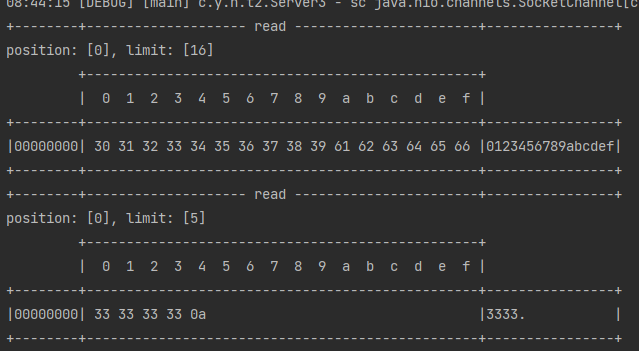
如何解决?
- 采用全局ByteBuffer,这里说的全局ByteBuffer指的是在同一个SelectionKey
- 当ByteBuffer大小不足时,自动扩容成2倍
@Slf4j
public class Server3 {
public static void main(String[] args) throws IOException {
//1.创建selector
Selector selector = Selector.open();
//2.创建用于监听服务连接的channel
ServerSocketChannel ssc = ServerSocketChannel.open();
ssc.bind(new InetSocketAddress(8080));
ssc.configureBlocking(false);
//3.将channel注册到selector中
SelectionKey sscKey = ssc.register(selector, 0, null);
log.debug("register key : {}",sscKey);
//4.设置channel的监听事件类型 OP_ACCEPT 代表连接事件
sscKey.interestOps(SelectionKey.OP_ACCEPT);
while (true) {
// select() 没有事件发生,线程阻塞;有事件发生,线程恢复运行
selector.select();
// 处理事件
Iterator<SelectionKey> iterator = selector.selectedKeys().iterator();
while (iterator.hasNext()) {
SelectionKey key = iterator.next();
//判断事件类型
if (key.isAcceptable()) {
//如果是接收类型
log.debug("key :{}",key);
ServerSocketChannel channel = (ServerSocketChannel) key.channel();
SocketChannel sc = channel.accept();
sc.configureBlocking(false);
log.debug("sc {}",sc);
//将sc注册到selector中,监听读入事件
ByteBuffer buffer = ByteBuffer.allocate(16); //将buffer绑定到SelectionKey
SelectionKey scKey = sc.register(selector, SelectionKey.OP_READ,buffer);
}else if (key.isReadable()) {
//如果是读入类型
try {
SocketChannel channel = (SocketChannel) key.channel();
ByteBuffer buffer = (ByteBuffer) key.attachment();
int read = channel.read(buffer); //当服务端断开连接时,返回值为-1
if (read == -1) {
key.cancel();
}else {
//将buffer根据指定字符分割
split(buffer);
if (buffer.position() == buffer.limit()) {//代表没读到一个完整信息
//创建一个扩容的bytebuffer,复制原来buffer中的信息,并新的buffer存到key中
ByteBuffer newBuffer = ByteBuffer.allocate(buffer.capacity() * 2);
buffer.flip();
newBuffer.put(buffer);
key.attach(newBuffer);
}
}
} catch (IOException e) {
e.printStackTrace();
key.cancel();
}
}
iterator.remove();
}
}
}
private static void split(ByteBuffer buffer) {
//将buffer转为读模式
buffer.flip();
int limit = buffer.limit();
for (int i = 0; i < limit; i++) {
if (buffer.get(i) == '\n') {
int length = i + 1 - buffer.position();
//用一个ByteBuffer存起来
ByteBuffer temp = ByteBuffer.allocate(length);
buffer.limit(i + 1);
//从buffer读,写到temp
temp.put(buffer);
ByteBufferUtil.debugAll(temp);
buffer.limit(limit);
}
}
buffer.compact();
}
}
修改完后,发现即使超过了指定长度,也可以读到一条完整信息

ByteBuffer 大小分配
- 每个 channel 都需要记录可能被切分的消息,因为 ByteBuffer 不能被多个 channel 共同使用,因此需要为每个 channel 维护一个独立的 ByteBuffer
- ByteBuffer 不能太大,比如一个 ByteBuffer 1Mb 的话,要支持百万连接就要 1Tb 内存,因此需要设计大小可变的 ByteBuffer
- 一种思路是首先分配一个较小的 buffer,例如 4k,如果发现数据不够,再分配 8k 的 buffer,将 4k buffer 内容拷贝至 8k buffer,优点是消息连续容易处理,缺点是数据拷贝耗费性能,参考实现 http://tutorials.jenkov.com/java-performance/resizable-array.html
- 另一种思路是用多个数组组成 buffer,一个数组不够,把多出来的内容写入新的数组,与前面的区别是消息存储不连续解析复杂,优点是避免了拷贝引起的性能损耗
4.5 处理write事件
一次无法写完
当服务端发送大量消息时,有时候因为消息过长,导致一次无法写完,服务端一次能发送多少消息,是由系统的缓存区决定的,当缓存区满时,就无法写入消息
服务端
public class WriteServer {
public static void main(String[] args) throws IOException {
ServerSocketChannel ssc = ServerSocketChannel.open();
ssc.configureBlocking(false);
ssc.bind(new InetSocketAddress(8080));
Selector selector = Selector.open();
ssc.register(selector, SelectionKey.OP_ACCEPT);
while (true) {
selector.select();
Iterator<SelectionKey> iter = selector.selectedKeys().iterator();
while (iter.hasNext()) {
SelectionKey key = iter.next();
iter.remove();
if (key.isAcceptable()) {
SocketChannel sc = ssc.accept();
sc.configureBlocking(false);
sc.register(selector,0,null);
// 模拟发送大量数据
StringBuilder sb = new StringBuilder();
for (int i = 0; i < 30000000; i++) {
sb.append("a");
}
ByteBuffer buffer = Charset.defaultCharset().encode(sb.toString());
while (buffer.hasRemaining()) {
//如果buffer中有数据没发完
int write = sc.write(buffer);
System.out.println(write);
}
}
}
}
}
}
客户端
public class WriteClient {
public static void main(String[] args) throws IOException {
Selector selector = Selector.open();
SocketChannel sc = SocketChannel.open();
sc.configureBlocking(false);
sc.register(selector, SelectionKey.OP_CONNECT | SelectionKey.OP_READ);
sc.connect(new InetSocketAddress("localhost", 8080));
int count = 0;
while (true) {
selector.select();
Iterator<SelectionKey> iter = selector.selectedKeys().iterator();
while (iter.hasNext()) {
SelectionKey key = iter.next();
iter.remove();
if (key.isConnectable()) {
System.out.println(sc.finishConnect());
} else if (key.isReadable()) {
ByteBuffer buffer = ByteBuffer.allocate(1024 * 1024);
count += sc.read(buffer);
buffer.clear();
System.out.println(count);
}
}
}
}
}
测试
启动代码,发现服务端发一部分停一下子,这是由于缓存区满了,但是网络原因还没有及时的将缓存区的数据发送出去,所以导致无法像缓存区写入,虽然结果是客户端收到了完整的消息,但这种情况属于阻塞,会导致其他的事件无法正常运行
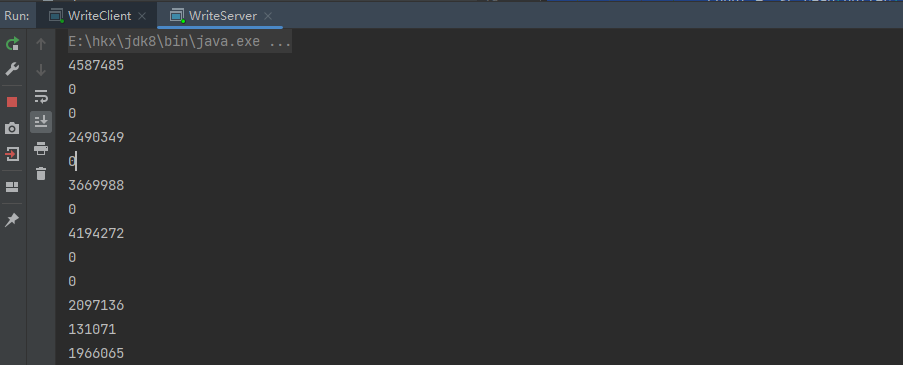
解决方案
如果有数据没有写完,不采取循环的方式,而是将他存到write事件中
修改服务端
public class WriteServer {
public static void main(String[] args) throws IOException {
ServerSocketChannel ssc = ServerSocketChannel.open();
ssc.configureBlocking(false);
ssc.bind(new InetSocketAddress(8080));
Selector selector = Selector.open();
ssc.register(selector, SelectionKey.OP_ACCEPT);
while (true) {
selector.select();
Iterator<SelectionKey> iter = selector.selectedKeys().iterator();
while (iter.hasNext()) {
SelectionKey key = iter.next();
iter.remove();
if (key.isAcceptable()) {
SocketChannel sc = ssc.accept();
sc.configureBlocking(false);
SelectionKey scKey = sc.register(selector, 0, null);
// 模拟发送大量数据
StringBuilder sb = new StringBuilder();
for (int i = 0; i < 30000000; i++) {
sb.append("a");
}
ByteBuffer buffer = Charset.defaultCharset().encode(sb.toString());
//先发送一次
int write = sc.write(buffer);
System.out.println(write);
//如果buffer中还有数据没发完
if (buffer.hasRemaining()) {
//在原有监听事件的基础上加上写事件
scKey.interestOps(scKey.interestOps() + SelectionKey.OP_WRITE);
//buffer绑定到key中
scKey.attach(buffer);
}
}else if (key.isWritable()) {
SocketChannel sc = (SocketChannel) key.channel();
ByteBuffer buffer = (ByteBuffer) key.attachment();
int write = sc.write(buffer);
System.out.println(write);
if (!buffer.hasRemaining()) { // 写完了
key.interestOps(key.interestOps() - SelectionKey.OP_WRITE);
key.attach(null);
}
}
}
}
}
}
write 为何要取消
只要向 channel 发送数据时,socket 缓冲可写,这个事件会频繁触发,因此应当只在 socket 缓冲区写不下时再关注可写事件,数据写完之后再取消关注
4.6 多线程优化
现代计算机都是多核 cpu,设计时要充分考虑别让 cpu 的力量被白白浪费
前面的代码只有一个选择器,没有充分利用多核 cpu,如何优化呢?
如下图所示,分两组选择器
- 单线程配一个选择器,专门处理 accept 事件
- 创建 cpu 核心数的线程,每个线程配一个选择器,轮流处理 read 事件
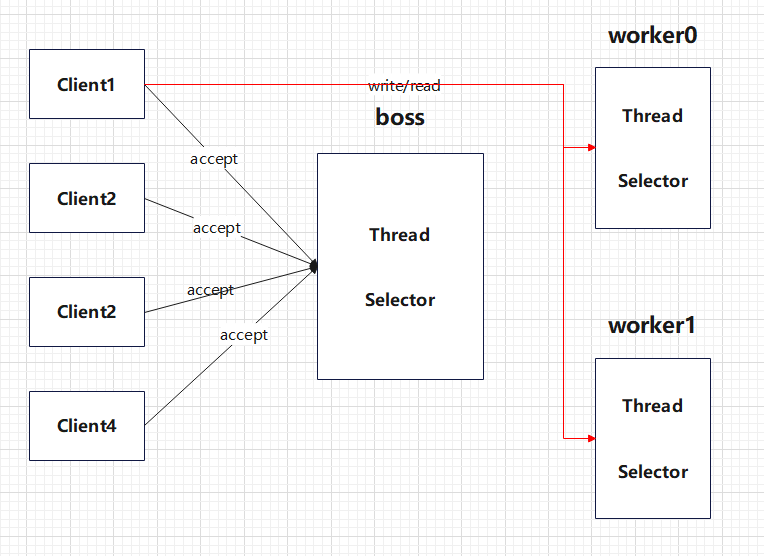
代码实现
目前代码并不是完整的,还有许多漏洞需要一步步处理
客户端
public class ThreadClient {
public static void main(String[] args) throws IOException {
SocketChannel sc = SocketChannel.open();
sc.connect(new InetSocketAddress("localhost",8080));
sc.write(Charset.defaultCharset().encode("0123456789abcdef"));
System.in.read();
}
}
服务端
@Slf4j
public class ThreadServer {
public static void main(String[] args) throws IOException {
//负责处理连接事项的boss线程
Thread.currentThread().setName("boss");
Selector boss = Selector.open();
ServerSocketChannel ssc = ServerSocketChannel.open();
ssc.bind(new InetSocketAddress(8080));
ssc.configureBlocking(false);
ssc.register(boss,SelectionKey.OP_ACCEPT);
Worker worker = new Worker("worker-0");
worker.init();
while (true) {
boss.select();
Iterator<SelectionKey> iter = boss.selectedKeys().iterator();
while (iter.hasNext()) {
SelectionKey sscKey = iter.next();
iter.remove();
if (sscKey.isAcceptable()) {
SocketChannel sc = ssc.accept();
sc.configureBlocking(false);
log.debug("connected...{}",sc.getRemoteAddress());
//将sc注册到worker中的selector中
log.debug("before register...{}",sc.getRemoteAddress());
sc.register(worker.selector,SelectionKey.OP_READ);
log.debug("after register...{}",sc.getRemoteAddress());
}
}
}
}
//负责处理读写事项的线程
static class Worker implements Runnable{
private Thread thread; // 每一个worker独享一个线程
private Selector selector; // 每一个worker拥有一个selector
private String name; // 线程名称
private volatile boolean start = false; // worker是否第一次运行
public Worker(String name) {
this.name = name;
}
//初始化worker,start可以保证一个worker中使用同一个thread以及selector
public void init() throws IOException {
if (!start) {
thread = new Thread(this, name);
selector = Selector.open();
thread.start();
start = true;
}
}
//演示只处理简单的读入请求
@Override
public void run() {
while (true) {
try {
selector.select(); //阻塞
Iterator<SelectionKey> iter = selector.selectedKeys().iterator();
while (iter.hasNext()) {
SelectionKey scKey = iter.next();
iter.remove();
if (scKey.isReadable()) {
SocketChannel channel = (SocketChannel) scKey.channel();
ByteBuffer buffer = ByteBuffer.allocate(16);
channel.read(buffer);
buffer.flip();
ByteBufferUtil.debugRead(buffer);
}
}
} catch (IOException e) {
throw new RuntimeException(e);
}
}
}
}
}
无法读入数据
运行上述代码后,发现服务端并没有输出客户端发送的消息,也就是说这一步注册并没有注册成功
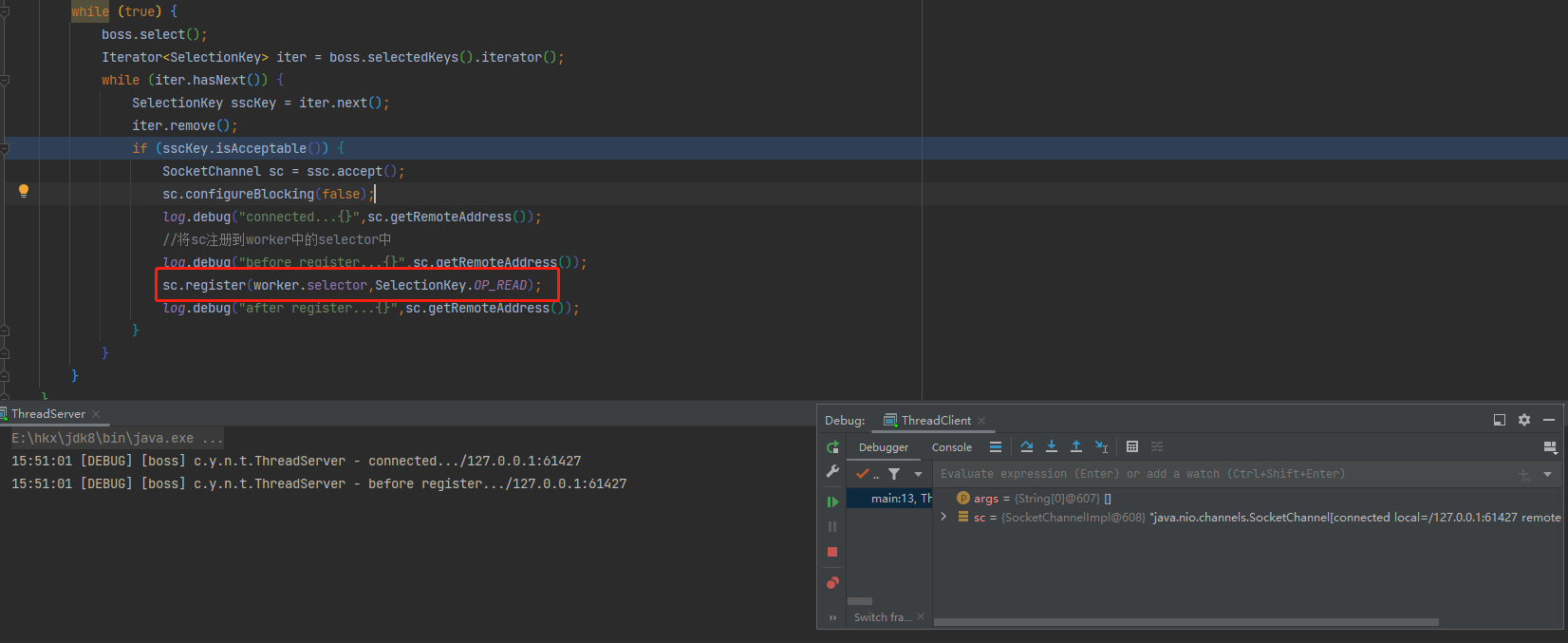
这是因为worker-0中的selector.select()是个阻塞方法,现在的运行顺序如下,worker-0中的selector以及被阻塞,所以无法将sc注册到该selector
解决方案
使用selector.wakeup()让释放堵塞,让注册在worker-0线程中运行
@Slf4j
public class ThreadServer {
public static void main(String[] args) throws IOException {
//负责处理连接事项的boss线程
Thread.currentThread().setName("boss");
Selector boss = Selector.open();
ServerSocketChannel ssc = ServerSocketChannel.open();
ssc.bind(new InetSocketAddress(8080));
ssc.configureBlocking(false);
ssc.register(boss,SelectionKey.OP_ACCEPT);
Worker worker = new Worker("worker-0");
while (true) {
boss.select();
Iterator<SelectionKey> iter = boss.selectedKeys().iterator();
while (iter.hasNext()) {
SelectionKey sscKey = iter.next();
iter.remove();
if (sscKey.isAcceptable()) {
SocketChannel sc = ssc.accept();
sc.configureBlocking(false);
log.debug("connected...{}",sc.getRemoteAddress());
//将sc注册到worker中的selector中
log.debug("before register...{}",sc.getRemoteAddress());
worker.init(sc); //****修改****
}
}
}
}
//负责处理读写事项的线程
static class Worker implements Runnable{
private Thread thread; // 每一个worker独享一个线程
private Selector selector; // 每一个worker拥有一个selector
private String name; // 线程名称
private volatile boolean start = false; // worker是否第一次运行
//****修改****
private ConcurrentLinkedQueue<Runnable> queue = new ConcurrentLinkedQueue<>();
public Worker(String name) {
this.name = name;
}
//初始化worker,start可以保证一个worker中使用同一个thread以及selector
public void init(SocketChannel sc) throws IOException {
if (!start) {
thread = new Thread(this, name);
selector = Selector.open();
thread.start();
start = true;
}
//****修改****
queue.add(() -> {
try {
sc.register(selector,SelectionKey.OP_READ);
log.debug("after register...{}",sc.getRemoteAddress());
} catch (IOException e) {
throw new RuntimeException(e);
}
});
//释放阻塞
selector.wakeup();
}
//演示只处理简单的读入请求
@Override
public void run() {
while (true) {
try {
selector.select(); //阻塞
//****修改****
Runnable task = queue.poll();
if (task != null) {
task.run();
}
Iterator<SelectionKey> iter = selector.selectedKeys().iterator();
while (iter.hasNext()) {
SelectionKey scKey = iter.next();
iter.remove();
if (scKey.isReadable()) {
SocketChannel channel = (SocketChannel) scKey.channel();
ByteBuffer buffer = ByteBuffer.allocate(16);
channel.read(buffer);
buffer.flip();
ByteBufferUtil.debugRead(buffer);
}
}
} catch (IOException e) {
throw new RuntimeException(e);
}
}
}
}
}
多worker实现
上面实现了单worker处理读事项,还没有达到多线程的目的,现在修改创建多个worker,利用ribbon中负载均衡的思想,让多线程轮询处理事项
修改boss线程中的代码
public static void main(String[] args) throws IOException {
//负责处理连接事项的boss线程
Thread.currentThread().setName("boss");
Selector boss = Selector.open();
ServerSocketChannel ssc = ServerSocketChannel.open();
ssc.bind(new InetSocketAddress(8080));
ssc.configureBlocking(false);
ssc.register(boss,SelectionKey.OP_ACCEPT);
Worker[] workers = new Worker[2];
for (int i = 0; i < workers.length; i++) {
workers[i] = new Worker("worker-" + i);
}
//负载均衡计数器
AtomicInteger atomicInteger = new AtomicInteger();
while (true) {
boss.select();
Iterator<SelectionKey> iter = boss.selectedKeys().iterator();
while (iter.hasNext()) {
SelectionKey sscKey = iter.next();
iter.remove();
if (sscKey.isAcceptable()) {
SocketChannel sc = ssc.accept();
sc.configureBlocking(false);
log.debug("connected...{}",sc.getRemoteAddress());
//将sc注册到worker中的selector中
log.debug("before register...{}",sc.getRemoteAddress());
workers[atomicInteger.getAndIncrement() % workers.length].init(sc);
}
}
}
}
测试
可以看到,事项以轮询的方式交给多个worker处理

如何拿到 cpu 个数
一般情况下,这个线程数我们回设置的与物理cpu个数相同,可以调用Runtime.getRuntime().availableProcessors() 获取cpu个数
- Runtime.getRuntime().availableProcessors() 如果工作在 docker 容器下,因为容器不是物理隔离的,会拿到物理 cpu 个数,而不是容器申请时的个数
- 这个问题直到 jdk 10 才修复,使用 jvm 参数 UseContainerSupport 配置, 默认开启


